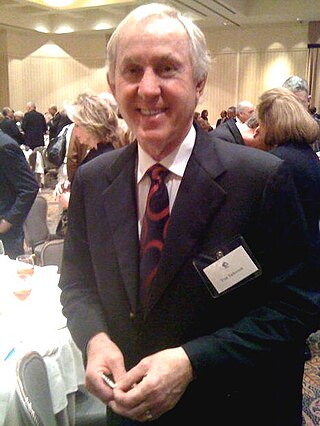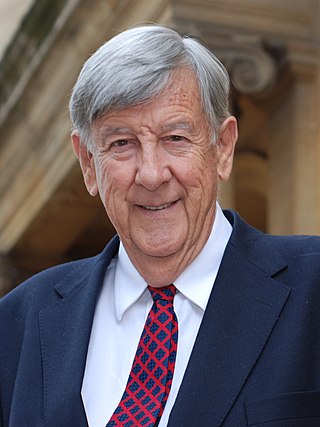The Software Engineering Body of Knowledge is an international standard ISO/IEC TR 19759:2005 specifying a guide to the generally accepted software engineering body of knowledge.
Software development is the process used to conceive, specify, design, program, document, test, and bug fix in order to create and maintain applications, frameworks, or other software components. Software development involves writing and maintaining the source code, but in a broader sense, it includes all processes from the conception of the desired software through the final manifestation, typically in a planned and structured process often overlapping with software engineering. Software development also includes research, new development, prototyping, modification, reuse, re-engineering, maintenance, or any other activities that result in software products.

Francis Asbury Tarkenton is an American former football quarterback who played in the National Football League (NFL) for 18 seasons, primarily with the Minnesota Vikings. He played college football at the University of Georgia, where he was recognized as a twice first-team All-SEC, and was selected by the Vikings in the third round of the 1961 NFL Draft. After retiring from football, he became a media personality and computer software executive.
A domain-specific language (DSL) is a computer language specialized to a particular application domain. This is in contrast to a general-purpose language (GPL), which is broadly applicable across domains. There are a wide variety of DSLs, ranging from widely used languages for common domains, such as HTML for web pages, down to languages used by only one or a few pieces of software, such as MUSH soft code. DSLs can be further subdivided by the kind of language, and include domain-specific markup languages, domain-specific modeling languages, and domain-specific programming languages. Special-purpose computer languages have always existed in the computer age, but the term "domain-specific language" has become more popular due to the rise of domain-specific modeling. Simpler DSLs, particularly ones used by a single application, are sometimes informally called mini-languages.

Computer-aided software engineering (CASE) was a domain of software tools used to design and implement applications. CASE tools were similar to and were partly inspired by Computer-Aided Design (CAD) tools used for designing hardware products. CASE tools were intended to help develop high-quality, defect-free, and maintainable software. CASE software was often associated with methods for the development of information systems together with automated tools that could be used in the software development process.
The Programmer's Workbench (PWB/UNIX) is an early, now discontinued, version of the Unix operating system that had been created in the Bell Labs Computer Science Research Group of AT&T. Its stated goal was to provide a time-sharing working environment for large groups of programmers, writing software for larger batch processing computers.
Language-oriented programming (LOP) is a software-development paradigm where "language" is a software building block with the same status as objects, modules and components, and rather than solving problems in general-purpose programming languages, the programmer creates one or more domain-specific languages (DSLs) for the problem first, and solves the problem in those languages. Language-oriented programming was first described in detail in Martin Ward's 1994 paper Language Oriented Programming, published in Software - Concepts and Tools, Vol.15, No.4, pp 147–161, 1994.
GXL is designed to be a standard exchange format for graphs. GXL is an extensible markup language (XML) sublanguage and the syntax is given by an XML document type definition (DTD). This exchange format offers an adaptable and flexible means to support interoperability between graph-based tools.

James Martin was an English information technology consultant and author, known for his work on information technology engineering.
Multilayered extended semantic networks (MultiNets) are both a knowledge representation paradigm and a language for meaning representation of natural language expressions that has been developed by Prof. Dr. Hermann Helbig on the basis of earlier Semantic Networks. It is used in a question-answering application for German called InSicht. It is also used to create a tutoring application developed by the university of University of Hagen to teach MultiNet to knowledge engineers.
Knowledge-based engineering (KBE) is the application of knowledge-based systems technology to the domain of manufacturing design and production. The design process is inherently a knowledge-intensive activity, so a great deal of the emphasis for KBE is on the use of knowledge-based technology to support computer-aided design (CAD) however knowledge-based techniques can be applied to the entire product lifecycle.
Sterling Software was an American software company founded in Dallas, Texas, in 1981 by Sterling Williams and brothers Sam and Charles Wyly. The company was acquired by Computer Associates International in 2000 in a stock-for-stock transaction worth $3.3 billion. Computer Associates sold Sterling Software's Federal Systems Group to Northrop Grumman in 2000.
Model-driven engineering (MDE) is a software development methodology that focuses on creating and exploiting domain models, which are conceptual models of all the topics related to a specific problem. Hence, it highlights and aims at abstract representations of the knowledge and activities that govern a particular application domain, rather than the computing concepts.
A test bench or testing workbench is an environment used to verify the correctness or soundness of a design or model.
Albert F. Case Jr. is an American software engineer and one of the leaders in the development of computer-aided software engineering (CASE) technologies and system development methodologies.
LanguageWare is a natural language processing (NLP) technology developed by IBM, which allows applications to process natural language text. It comprises a set of Java libraries which provide a range of NLP functions: language identification, text segmentation/tokenization, normalization, entity and relationship extraction, and semantic analysis and disambiguation. The analysis engine uses Finite State Machine approach at multiple levels, which aids its performance characteristics, while maintaining a reasonably small footprint.
Rational Synergy is a software tool that provides software configuration management (SCM) capabilities for all artifacts related to software development including source code, documents and images as well as the final built software executable and libraries. Rational Synergy also provides the repository for the change management tool known as Rational Change. Together these two tools form an integrated configuration management and change management environment that is used in software development organizations that need controlled SCM processes and an understanding of what is in a build of their software.
SEMAT is an initiative to reshape software engineering such that software engineering qualifies as a rigorous discipline. The initiative was launched in December 2009 by Ivar Jacobson, Bertrand Meyer, and Richard Soley with a call for action statement and a vision statement. The initiative was envisioned as a multi-year effort for bridging the gap between the developer community and the academic community and for creating a community giving value to the whole software community.
Bernhard Rumpe is a German computer scientist, professor of computer science and head of the Software Engineering Department at the RWTH Aachen University. His research focusses on "technologies, methods, tools ... necessary to create software in the necessary quality that is as efficient and sustainable as possible."


